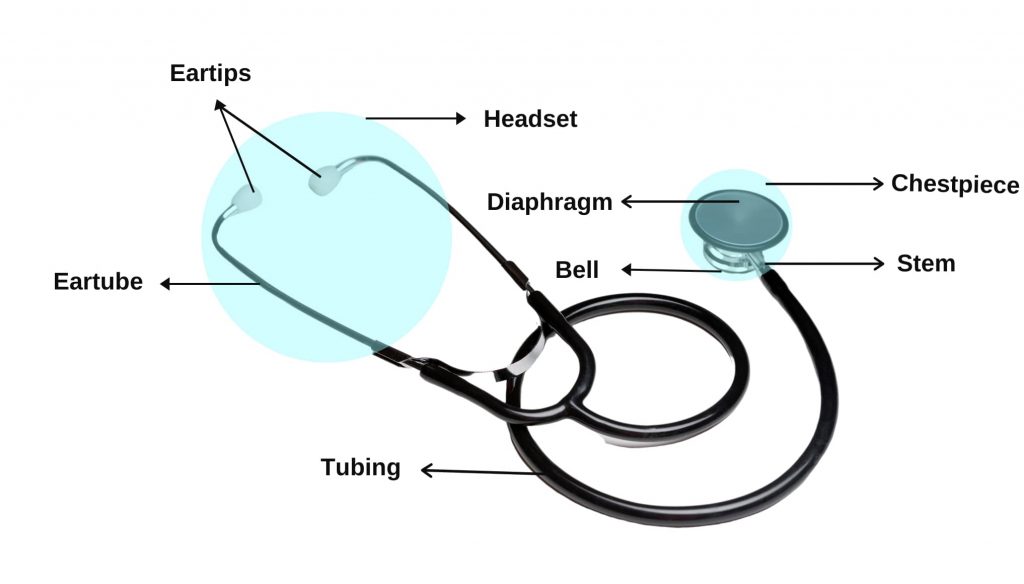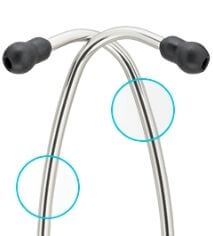Did you ever think about the parts of a stethoscope?
This article is related to stethoscopes information. Furthermore, this article attempts to provide its audience with a clear understanding of the specific components of a stethoscope. Whereas their corresponding anatomies (structures) and physiology (functions).
This will educate the audience with the skills to identify the structural elements and state various functionalities of stethoscope parts.
Today, you will be able to know parts of a stethoscope along with some other useful information.
However, if we talk about the design and material of a stethoscope, then most of the stethoscopes made up of “Y” design with some rubber tubing.
Now, you will be wondering why it is shaped like an alphabet “Y”. It is because it can allow a medical professional to fit them into both ears and from the long tube he could easily hear the sounds inside a patient without any hassles.
What is a stethoscope?
A stethoscope is the most important icon of medicine used to determine the sound accurately, produced inside the body of an animal and human body.
Stethoscopes are the acoustic medical device that is mainly useful for auscultation. In simple words, the purpose of a stethoscope is to listen to various types of sounds inside a body.
The sounds might include blood flow inside a body, any particular sound like water inside a patient’s body when a patient is suffering from any kidney or liver illness.
Furthermore, it can even allow you to hear the sound of a heartbeat of an unborn baby child inside a pregnant woman.
Listening to the internal sounds of a human being can be very complicated if a doctor or a nurse does not have the best stethoscope for diagnosis. And to have the best one, you must have knowledge about the structure and functionality of a stethoscope.
Table of Content
What are the Parts of a Stethoscope & Its Purpose?
Stethoscope Labeled Diagram

The parts might include;
- Headset
- Ear tips
- Ear tubes
- Tension springs
- Tubing
- Chest piece
- The stem
- Diaphragm
- Bell
1-Headset
The headset is a part of a stethoscope, which is a combination of ear tips and ear tubes, and tension springs. These components combine together to fulfilling the purpose of diagnosis.
It provides a comfortable alignment in the ears of a user and further used to provide maximum quality of sound through the headset.
The headset’s ear tips pointing towards the user’s nose as seen from the hand whilst the ear tubes partially hang back. It makes for an effective transfer of sound through the ear passage such that there has minimum interference from the stethoscope.
2-Ear Tips
The upper part of a stethoscope contains the ear tips, which are used for sticking it into the ears. They receive sounds from the most important part of a stethoscope “chest piece”.
In addition, the ear tips construct with silicone or rubber material. They are intended to build a form-fitting seal within the ears, which helps to prevent unnecessary noises to stay out of the ears during diagnosis.
To users who spend more time examining the safety of their patients with their stethoscopes, a good pair of comfortable ear tips can be very much essential at these moments.
That is how a good pair of ear tips will make all the difference between an unpleasant or uncomfortable experience and a relaxed one.
All ear tips made up of a thick, versatile substance that is designed to match and comfort the inner side of the ears. A transparent space in the middle use to convey sound into them, and either a wired or smooth interior at the opposite end of the ear tips where the stethoscope ear tubes slip through.
3-Ear Tubes
The ear tubes are the metal part of a stethoscope. The tube first connects to the ear tips, and second, it connects to the tubing, which further joins with the chest piece.
The main purpose of the ear tube is to isolate well and transfer the noises to the user’s ears without compromising the quality. It also helps to split the sounds between the right and the wrong channels and have a pleasant listening atmosphere.
However, to help in the diagnosis of a patient, this isolation can be very helpful.
4-Tension Springs
The headset tension balance for human performance and comfort by moving the ear tubes apart to minimize stress, or pressing themselves together to maximize tension.
5-Tubing
The stethoscope’s soft, flexible line is its tubing. It can be relatively short, depending on the brand and the quality of a stethoscope. Next-generation tubing offers greater skin oils and alcohol tolerance for having a longer tube life.
In the tubing or any other part, no natural rubber latex or phthalate plasticizers are used, probably to better protect human health and environmental issues.
Now, it depends on the model and the brand of a stethoscope that is chosen. This is because even with a single tube or dual-lumen tube design, the tubing could be made.
6-Chest Piece
The stethoscope’s chest-piece or head is made up of the attached Stem, diaphragm, and bell.
Many stethoscopes’ models have a single chest piece and a tunable diaphragm.
Similarly, most of them have a two-sided/double-headed chest piece, which consists of one side, a diaphragm on one side, and a bell on the other side.
Some chest pieces function better when pressed to the skin of patients, although certain larger, high-quality stethoscopes might pick noises through thin fabric layers.
The stethoscope chest piece part is used to listen to patients’ noises that are notified by putting the chest piece diaphragm or bell end on the chest of a patient, back, or stomach as well.
7-The Stem
The metal part of a stethoscope, which connects chest pieces and tubing together, is the Stem.
Besides attaching the two stethoscope’s components together, it often helps a medical professional to switch from the chest pieces’ diaphragm to the bell by rotating the chest piece side and pressing it through the ball-bearing.
Whereas, on the other hand, when rotating the two-sided chest piece, it helps to connect to the acoustic direction on the Stem.
8-Diaphragm
The chest-pieces’ wide circular component is the diaphragm. Most diaphragms feature a non-chill, hypoallergenic diaphragm, which is to make sure that the patient is diagnosed for greater convenience.
The diaphragm has two sides. Therefore, the larger one is normally for adult patients, while the bell with a smaller diameter is for children and thin patients.
This part of a stethoscope helps EMT to respond to a larger portion of patients’ body by picking up higher frequency noises as compare to the chest piece half of the bell in case of emergency.
9-Bell
The bell side is small as compared to the diaphragm side. It is a component of a chest piece that focuses on a smaller range of listening for lower frequency noises.
However, these types of noises are hard to detect inside a body of patients, but the bell side allows the medical professional to detect these noises without any hassles.
Below, you will able to distinguish between diaphragm and bell.
Bell Vs. Diaphragm
Stethoscopes are equipped with both diaphragm and bell chest pieces. A chest piece has a switch or a valve, which could help a medical professional to enable it to listen to the noises of the patient.
However, the main difference between the bell and diaphragm is that the bell feature is used to detect the lower frequency of sounds in patients, whereas, the diaphragm is used to detect the higher frequency of sounds in patients.

FAQs
What are the two sides of a stethoscope?
Two sides of the stethoscope refer to the diaphragm and bell. These two are the part of a chest piece in a stethoscope.
The first is the diaphragm, which is a flat metal disk, contains a flat plastic disk in turn. Additionally, the greater portion of a chest component is a diaphragm.
The other side of a chest piece is the bell, which is a hollow, bell-shaped piece constructed with metal and a tiny hole at the top.
When to Use Bell of Stethoscope?
There are most of the stethoscopes in the market that have two sides of a chest piece. However, these two sides have different functionality and purpose.
It is very necessary for a medical professional to know when to use a bell side of a stethoscope.
The basic purpose of a bell side is to allow a medical professional to detect low-frequency sound, therefore, the best is to use it when a professional is ready to check the patient with a thin body or pediatrics (children).
A stethoscope provides a number of essential parts for hearing and transmitting the internal noises of a patient’s body to the ears of healthcare professionals, which makes it easy to detect and manage the health problems of patients.
Without these essential parts, the stethoscope is incomplete or may not allow a health professional to easily detect the noises from the patient’s body.
Moreover, the chest piece is a very important part of a stethoscope because it provides a health professional with two different sides, one is the diaphragm and the other is the bell side that amplify sounds from the body.
The tubing connects these components, allowing sound transmission. Lastly, the binaural or earpieces, often with adjustable volume, enable healthcare professionals to listen to and analyze heart, lung, and other internal sounds.


